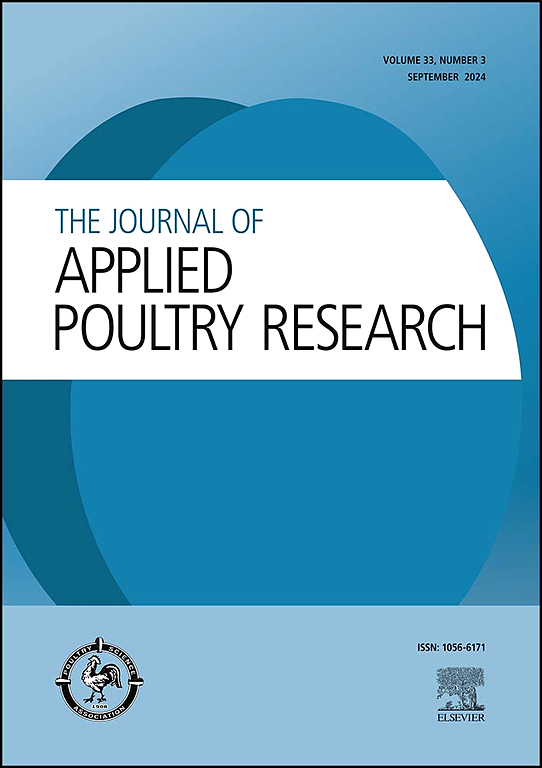Dietary lysine centered amino acid density tested across zinc levels in Ross male broilers
IF 2
3区 农林科学
Q2 AGRICULTURE, DAIRY & ANIMAL SCIENCE
引用次数: 0
Abstract
Broiler nutritionists often increase amino acid density in market conditions where soybean meal price is below average, and breast meat prices are above average. Resultant diets typically have higher lysine levels, coupled with higher levels of other essential and nonessential amino acids and soybean meal. This work assessed dietary amino acid balance across organic Zn source because Zn metabolism spans all known-six enzyme classes and plays a role in protein synthesis. Ross male 708-by-product broilers were fed three Lys-driven amino acid density levels across four added Zn levels in the form of Zn Lys Zn Glu from 1 to 14, 14-28, and 28-42 d of age (12 treatments replicated 6 times). Average dietary digestible Lys ranged from below to above primary breeder guidelines and averaged Zn ranged from 0 to 60 added ppm. Intermediate and total period data consisted of live production, processing transportation weight loss, processing uniformity, processed yields, and subsequent meat quality, of which interactions were minimal, indicating the independency of dietary variables tested herein. Increasing amino acid density improved live performance and breast meat yields, but at the expense of deteriorated meat quality. Higher Zn was needed to improve early livability (1-14 d) and flock uniformity at 42 d. Regarding Lys, feeding broilers 1.30, 1.20, 1.10 % digestible of diet resulted in improved live performance whereas 1.4, 1.3, and 1.2 % digestible resulted in the highest breast yield improvements.
以赖氨酸为中心的氨基酸密度对罗斯雄性肉鸡锌水平的影响
在豆粕价格低于平均水平,胸肉价格高于平均水平的市场条件下,肉鸡营养学家经常增加氨基酸密度。由此产生的饲料通常具有较高的赖氨酸水平,以及较高的其他必需和非必需氨基酸和豆粕水平。本研究评估了不同有机锌来源的膳食氨基酸平衡,因为锌代谢涵盖了所有已知的六种酶类,并在蛋白质合成中发挥作用。在1 ~ 14日龄、14 ~ 28日龄和28 ~ 42日龄分别饲喂4种不同锌水平(Zn - Lys- Zn - Glu)的赖氨酸驱动氨基酸密度水平(12个处理,重复6次)。饲粮平均可消化赖氨酸水平低于初级育种者指导值,添加ppm后平均锌含量为0 ~ 60。中期和全期数据包括活产量、加工运输减重、加工均匀性、加工产量和随后的肉质,它们之间的相互作用最小,表明本文所测试的饮食变量的独立性。增加氨基酸密度可提高活产性能和胸肉产量,但代价是肉质变差。提高肉鸡早期(1 ~ 14 d)的存活率和42 d时的鸡群均匀性需要较高的锌含量。在赖氨酸水平上,饲粮消化率为1.30、1.20、1.10%的肉鸡的活产性能得到改善,而乳产量提高最高的饲粮消化率为1.4、1.3和1.2%。
本文章由计算机程序翻译,如有差异,请以英文原文为准。
求助全文
约1分钟内获得全文
求助全文
来源期刊

Journal of Applied Poultry Research
农林科学-奶制品与动物科学
CiteScore
4.10
自引率
10.50%
发文量
80
审稿时长
104 days
期刊介绍:
The Journal of Applied Poultry Research (JAPR) publishes original research reports, field reports, and reviews on breeding, hatching, health and disease, layer management, meat bird processing and products, meat bird management, microbiology, food safety, nutrition, environment, sanitation, welfare, and economics. As of January 2020, JAPR will become an Open Access journal with no subscription charges, meaning authors who publish here can make their research immediately, permanently, and freely accessible worldwide while retaining copyright to their work. Papers submitted for publication after October 1, 2019 will be published as Open Access papers.
The readers of JAPR are in education, extension, industry, and government, including research, teaching, administration, veterinary medicine, management, production, quality assurance, product development, and technical services. Nutritionists, breeder flock supervisors, production managers, microbiologists, laboratory personnel, food safety and sanitation managers, poultry processing managers, feed manufacturers, and egg producers use JAPR to keep up with current applied poultry research.
 求助内容:
求助内容: 应助结果提醒方式:
应助结果提醒方式:


